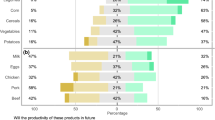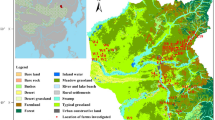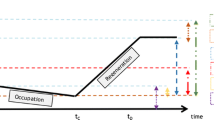Abstract
Purpose
This paper presents a case study of margarine, demonstrating the application of new characterisation factors (CF) for land use and a number of land use change impacts relating to biodiversity and ecosystem services. The objectives of this study were to generate insights as to the ease of applying these new factors and to assess their value in describing a number of environmental impacts from land use and land use change relating to the margarine product system.
Methods
This case study is a partial descriptive life cycle assessment (LCA) of margarine. The functional unit of the study is 500 g of packaged margarine used as a spread in the UK and Germany. The life cycle stages included were: agricultural production, oil processing, margarine manufacture and transportation to regional European distribution centres. Essential for the application of the new CF was the identification and quantification of the inventory flows for land occupation (land use) and land transformation (land use change) flows. A variety of methods have been applied to determine the inventory flows for the agricultural and industrial stages in the life cycle. These flows were then assessed using the new CF and land use-related environmental impact categories recommended in this special issue.
Results and discussion
Land occupation was the major determinant for all the new impact categories with the exception of the water purification potential. Many of the impact categories followed a similar pattern and therefore, the inventory result for land occupation in this case study explains a large share of most of the impacts. Where land occupation alone is not a suitable proxy for environmental impacts (i.e. for freshwater regulation potential), differentiation at the level of biomes has proven relevant. In addition, the land use types distinguished so far were found to be useful in highlighting likely hotspots in the life cycle, although further differentiation of ‘agricultural land’ is suggested to account for the differences between annual and permanent crops.
Conclusions
The new land use impact assessment methods applied help to identify hotspots in the life cycle of margarines, with different proportions and sources of vegetable oils. The specific impacts of each vegetable oil are determined mainly by the yield (and thus land occupation), but also by the type of agriculture (annual vs. permanent crops) and the sourcing location (and thus the sensitivity of biomes and occurrence of land use change). More research is needed to understand the usefulness of the various impact categories. For land use types, further refinement is required to describe different agricultural systems consistently across impact categories (e.g. annual vs. permanent cropping). In addition, the conceptual basis for the CFs applied in this case study (i.e. use of a potential reference for occupation and transformation) has limitations for some types of decisions normally supported by LCA.






Similar content being viewed by others
Notes
A cut-off criterion was applied so that ingredients constituting less than 0.5% of the weight of the total ingredients were omitted.
Proxy datasets were used for linseed and cassava as described in Nilsson et al. (2010).
This is due to the fact that the CF for tropical forests was used for oil palm plantations.
In addition, for CRP, an average value between pasture and forest was used, as this was considered a better fit for plantations.
References
Brandão M (2011) Food, feed, fuel, timber or carbon sink? Towards sustainable land use—a consequential life-cycle approach. University of Surrey, Guildford
Brandão M, Milà i Canals L (2012) Global characterisation factors to assess land use impacts on biotic production. Int J Life Cycle Assess (this issue)
Brandão M, Milà i Canals L, Clift R (2011) Soil organic carbon changes in the cultivation of energy crops: implications for GHG balances and soil quality for use in LCA. Biomass Bioenerg 35(2011):2323–2336
BSI (2008) PAS2050: Specification for the assessment of the life cycle greenhouse gas emissions of goods and services, British Standards Institution
de Baan L, Alkemade R, Koellner T (2012) Land use impacts on biodiversity in LCA: a global approach. Int J Life Cycle Assess (this issue)
FAOSTAT (2011a) Food and agricultural commodities production, from http://faostat.fao.org/site/567/default.aspx#ancor. Accessed 18 March 2011
FAOSTAT (2011b) Crop production data 1988–2008 from http://faostat.fao.org/site/567/default.aspx#ancor. Accessed 18 March 2011
FAOSTAT (2011c) Land data from http://faostat.fao.org/site/377/default.aspx#ancor. Accessed 18 March 2011
Flynn HC, Milà i Canals L, Keller E, King H, Sim S, Hastings A, Wang SF, Smith P (2011) Quantifying global greenhouse gas emissions from land use change for crop production. Glob Change Biol. doi:10.1111/j.1365-2486.2011.02618.x
Jönsson A, Björklund T, Tillman A-M (1998) LCA of concrete and steel building frames. Int J Life Cycle Assess 3(4):216–224
Kløverpris J, Wenzel H, Nielsen PH (2007) Life cycle inventory modelling of land use induced by crop consumption. Part 1: conceptual analysis and methodological proposal. Int J Life Cycle Assess 13(1):13–21
Koellner T, de Baan L, Brandão M, Milà i Canals L, Civit B, Margni M, Saad R, Maia de Souza D, Beck T, Müller-Wenk R (2012a) UNEP-SETAC guideline on global land use impact assessment on biodiversity and ecosystem services in LCA. Int J Life Cycle Assess (this issue)
Koellner T, de Baan L, Brandão M, Milà i Canals L, Civit B, Goedkoop M, Margni M, Weidema B, Wittstock B, Beck T, Müller-Wenk R (2012b) Principles for life cycle inventories of land use on a global scale. Int J Life Cycle Assess (this issue)
Lindeijer E, Müller-Wenk R, Steen B (eds) (2002) Impact assessment of resources and land use. In: Udo de Haes HA, Finnveden G, Goedkoop M, Hauschild M, Hertwich EG, Hofstetter P, Jolliet O, Klöpffer W, Krewitt W, Lindeijer EW, Müller-Wenk R, Olsen SI, Pennington DW, Potting J, Steen B (eds) Life cycle impact assessment: striving towards best practice. SETAC. Pensacola (USA), pp 11–64
Malaysian Palm Oil Board (MPOB) (2010) Life cycle assessment of Malaysian oil palm products from mineral soils including palm biodiesel
Milà i Canals L, Bauer C, Depestele J, Dubreuil A, Freiermuth Knuchel R, Gaillard G, Michelsen O, Müller-Wenk R, Rydgren B (2007) Key elements in a framework for land use impact assessment in LCA. Int J Life Cycle Assess 12(1):5–15
Müller-Wenk R, Brandão M (2010) Climatic impact of land use in LCA—carbon transfers between vegetation/soil and air. Int J Life Cycle Assess 15:172–182
Nilsson K, Flysjö A, Davis J, Sim S, Unger N, Bell S (2010) Comparative life cycle assessment of margarine and butter consumed in the UK, Germany and France. Int J Life Cycle Assess 15:916–926
Saad R, Margni M (2012) Land use impacts on freshwater regulation, erosion regulation and water purification: a spatial approach for a global scale level. Int J Life Cycle Assess (this issue)
Schmidt JH (2008) Development of LCIA characterisation factors for land use impacts on biodiversity. J Cleaner Prod 16:1929–1942
Shonfield PKA, Dumelin EE (2005) A life cycle assessment of spreads and margarines. Lipid Tech 17(9):199–203
Acknowledgements
Vanessa King provided significant input in terms of sourcing countries and growing seasons for the different crops; Dr Henry King reviewed the manuscript and improved its clarity significantly. The authors also wish to thank all the colleagues from the LC Initiative project who provided continuous support and updates of the characterisation factors during the writing of this paper. Two anonymous reviewers have provided significant comments to the manuscript and the layout for Fig. 1; their input is gratefully acknowledged.
Author information
Authors and Affiliations
Corresponding author
Additional information
Responsible editor: Thomas Koellner
Electronic supplementary material
Below is the link to the electronic supplementary material.
ESM 1
DOC 209 kb
Rights and permissions
About this article
Cite this article
Milà i Canals, L., Rigarlsford, G. & Sim, S. Land use impact assessment of margarine. Int J Life Cycle Assess 18, 1265–1277 (2013). https://doi.org/10.1007/s11367-012-0380-4
Received:
Accepted:
Published:
Issue Date:
DOI: https://doi.org/10.1007/s11367-012-0380-4




